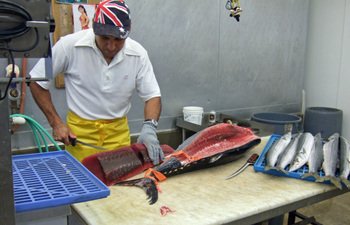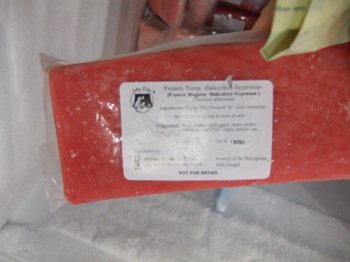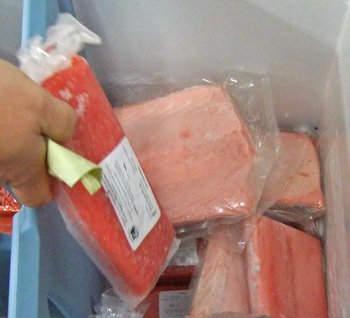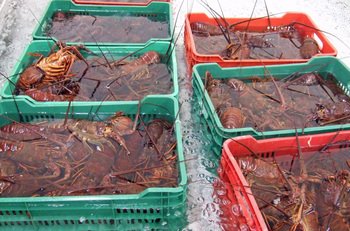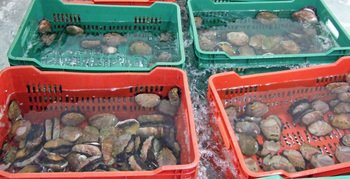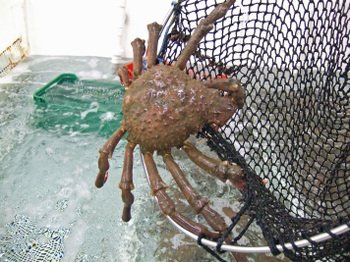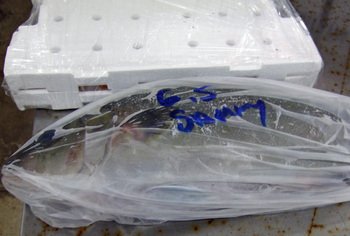I guess I must ask too many questions…… After a recent conversation on a slow evening at Sammy's, I gathered that Sam was tired of answering all my questions. Now Sam is a really nice guy, but I'm sure everyone has their limits. So I think Sam thought that he could change the subject and end this stream of seemingly unending questions, by giving me sort of a ultimatum. "Kirk-san, you know, I've got nothing to hide, and I always tell you everybody gets most of their Maguro from the same place. So if you ever want to come with me when I pick up Maguro please let me know…" You know what my response to that question was, right? "Just let me know where and when, and I'll be there."
Which is why, I ended up in a parking lot, waiting for Sam. When Sam arrived, he greeted me with a "Hello, Kirk-san how are you!" A short time later we passed through this blue door:
Into a bustling cold warehouse. Sam checked in at the office, and conducted some business, and few minutes later, after donning head covers we were in one of the many large chillers, and looking at tuna. The large chiller was lined with bins overflowing with ice and palettes with iced fish carcasses. While checking out fish Sam mentioned that he sees all of the well known Itamae here one time or another……
During the time I was checking things out, Sam was in conversation with the Young Man in charge of the chiller. The young man pulled out a fish that already had a quarter cut and sold….and the conversation went on a bit longer. Sam was after whole Maguro in the 70 plus pound range. Unfortunately, there was no whole Bluefin on this day, so Sam went into bargaining mode, mentally calculating how much maguro he'd need to hold over until tomorrow when he'll come again. Each fish had a orange tag with basic weight and other info on it. After the conversation Sam decided on purchasing a quarter of the partially cut fish, and a part of one of the pieces stored on ice.
Later on Sam told me that in order to get the optimum amount of Toro and fish, he needed a fish larger than 70 pounds. The 40 pound fish wouldn't provide enough toro to justify buying what was left of the fish.
One thing you quickly notice is how handling of the fish is second nature. All the maguro is handled on the "skin side" as much as possible to avoid contact with the meat.
Sam apologized for not having anything to "wow" me, but I thought this was an interesting little excursion. While waiting for the fish to be cut, a little dolly with 3 Styrofoam coolers were wheeled by with the word 'Ota' written on each….hmmm, we know where this one is going…..
As everything was being packed, Sam took me on a little tour and the conversation drifted to maguro, and various grades, prices, and the such. Eventually, we were chatting about what people tend to call "frozen fish", which confuses a bunch of people, after all aren't Bluefin flash frozen when they are caught? Well, let's just say not all maguro is created equal. Also, the word "freshness" can be a bit confusing as well, since unless Maguro is consumed immediately after being caught, the flesh of the fish will actually taste better after rigor mortis sets in and the muscle tissue starts to break down, creating a natural tenderization process. Think of it as it's own style of "dry-aging".
I remember seeing maguro being sold in a few stores(though not recently) and some sushi bars that were really abnormally cherry red, maguro is not naturally a bright cherry red. So of course I wanted to see, the infamous "frozen fish", having consumed enough of very low grade maguro, a bit off tasting, with a weird texture and color….. Sam led me to a freezer, and opened it, and picked out a pack of really artificially red looking precut fish.
This is what they call "Saku-Maguro", short for Sakudori, which is the word to describe the traditional way of cutting Maguro. So basically "cut-tuna". In this next photo you can compare the color of this precut maguro, with frozen maguro in the case.
Why is the color so different? It's because these filets have been treated with a process called "artificial smoking". You see, tuna flesh contains a pigmented protein that starts to change the color of the flesh when exposed to oxygen. If not treated the flesh will start to discolor very quickly. So it is usually treated with Carbon Monoxide to preserve the color of the flesh. What is not preserved is the quality of the tuna. To quote an anonymous source in a article from the New York Times:
"But "you could put it in the trunk of your car for a year, and it wouldn't turn brown," said one sales representative at Anova Foods, a distributor in Atlanta, who spoke on condition of anonymity."
You can read the article here. There's another really good article from the Washington Post, that you can read here.
So putting 2 and 2 together….this tuna is very inexpensive, do you think that it's the really top notch fish being processed in this manner? Sam did mention that he and most of the good sushi bars in San Diego won't serve the stuff. "Kirk-san, even if you were blind, you would be able to tell from the very first bite." Sam also told me that if you buy frozen, unsmoked raw maguro, that you should eat it within 12 hours of defrosting, otherwise it will start oxidizing very quickly.
I'm not much of a soapbox type of Guy, and think you should eat whatever you want. But I thought this was quite interesting.
Some other photos.
They call this the Lobster Room:
I think this is why:
But maybe they should call it the Abalone Room – look how clean the water is!
I felt like it was clean enough for me to drink, but I fear I may run into one of these fellows:
Some world class Uni comes out of this room:
Kanpachi anyone?
Have a great week!



